Ellen and Jim Have a Blog, Too
We are two part-time academics. Ellen teaches in the English department and Jim in the IT program at George Mason University.


The ending of Pallisers 5:10 an ironic climax to the ending of 1:1, & the emergence of Madame Max · 14 April 08
Dear Harriet,
I’ve now outlined the modern or thematic perspective, a double life, which Raven uses to reshape Trollope’s Phineas matter in 5:10. This is my second letter on this part: a summary of the episodes for Part 10 of the 1974 BBC Palliser films, with commentary. I will again include transcriptions of a few striking dialogues and stills. Both make the summary letter a bit long, but I’d rather not divide the letter into two.
To review the Phineas matter: Pallisers 4:8 allowed politics, social and economic to dominate the hour; Pallisers 5:9, private relationships where two characters, came together for reasons of emotional (& therefore ideological) affinity or where they were forced or chose based on material or social advantage and find themselves deeply discordant or having real trouble adjusting to one another. Pallisers 5:10 still emphasizes the private, but begins to allow pivotal events in the story to be shaped by public or more general social and economic politics once again. I
Volume 5, Part 10, Episode 6: “The Duel” Scene 1) A beach on Bruges, under the ritual control of Laurence Fitzgibbon (Neil Stacy) and Colonel Colepepper (Dallas Cavell) a stunning depiction of the duel between Phineas (Donald McCann) and Chiltern (John Hallam). Apparently (it’s not clear while the scene is played out before us) Phineas shoots not to hurt Chiltern, while Chiltern shoots to kill, or at least seriously maim. This is a fourth central confrontation where Hugh David, the series’ director exploits the highly pictorial nature of the medium in a relatively small space to make a strong theatrical impact. There will be two more in this episode.
We see the two men slowly emerge:
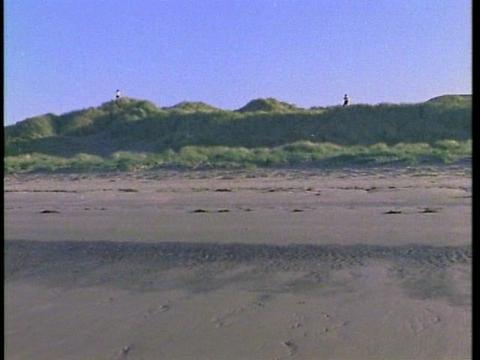
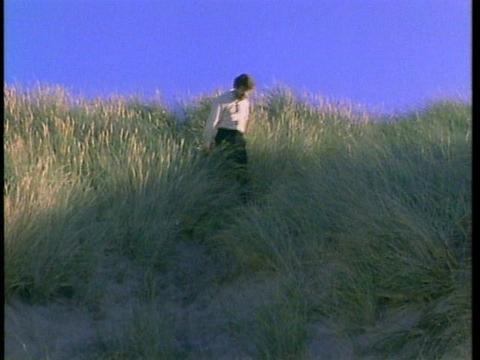
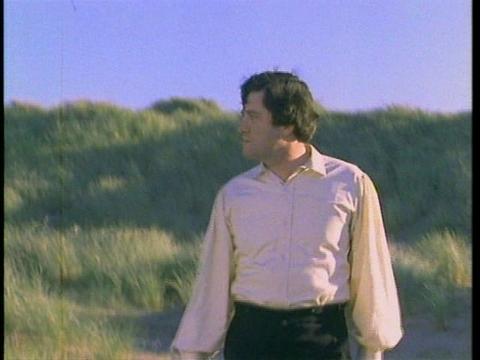
Phineas Finn (Donal McCann) and Lord Chiltern (John Hallam) slowly emerge (‘74 BBC Pallisers)
And then we watch each step of the ritual; here is one of the most striking which matches those which have gone before and those to come:
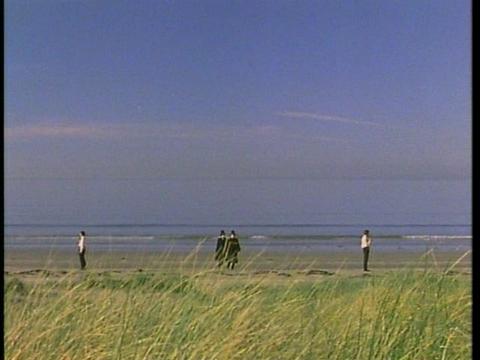
The other are the opening coerced match of Lady Glencora McClusky (Susan Hampshire) and Plantagenet Palliser (Philip Latham) (1:1); the instinctive drawing together across a wide space at a fencing academy of Burgo (Barry Justice) and Lady Glen (1:2); later in this part (5:10) when Chiltern and Finn come slowly together (Phineas offers his hand; Chiltern in impulsive gesture gets close & suddenly fiercely hugs Phineas); and in this part’s close Lady Glen and Madame Max (Barbara Murray) across a floor over the Duke of Omnium (Roland Culver) (see below). Scene 2) The Office of the People’s Banner: we see Slide (Clifford Rose) writing a column for The People’s Banner where he presents Phineas’s career in the light of an unscrupulous womanizing careerist, and asks about “his late mysterious absence from the house and in what way came by the wound in his arm.” Scene 3) The Palliser Drawing Room. Dissolve from previous scene to show Lady Glen reading People’s Banner (with voice over of Rose as Slide finishing reading it); Barrington Erle (Moray Watson) comes to look over Lady Glen’s shoulder, then Dolly Longestaffe (Donald Pickering) joins in, and all three titillated (with maybe a rueful tone from Erle that they shouldn’t be) when Phineas, arm in sling, with Fitzgibbon, arrives; teasing games with innuendoes and puns (which even Phineas weakly joins in on) ensue until Palliser enters:
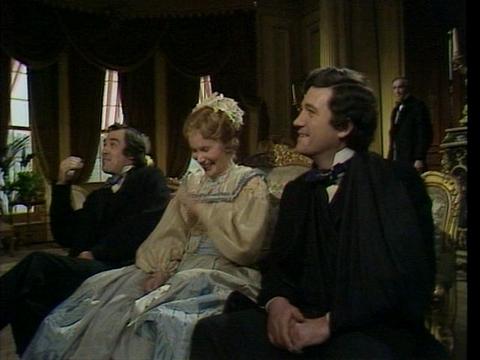
Phineas, Laurence Fitzgibbon (Neil Stacey) and Lady Glen (Susan Hampshire) joking about Finn’s duel with Chiltern.
As Pallisers is a serious-thinking & feeling individual who would be appalled at every aspect of what occurred, they divert him from genuinely seeking to find out what kind of shooting Finn has been up to.
Scene 3) Corridor outside Kennedy apartment in London; Phineas comes to Lady Laura Kennedy (Anna Massey) who’s relieved to see him; Scene 4) Kennedy apartment where Laura pours herself a drink. Just as soon as she confesses her agon over her love for him, he asks her to help him win Violet Effingham (Mel Martin); she is taken aback, angry for her brother; learning of the duel and how Phineas held back, she is moved, then distraught, refuses still, and asks him to leave.
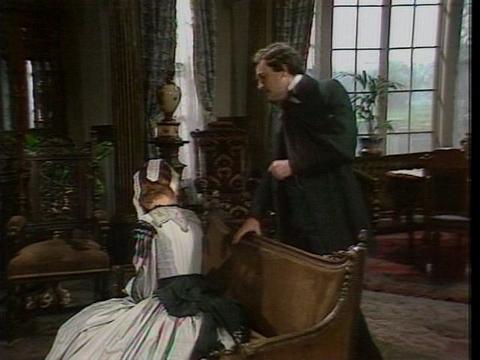
Phineas attempts to get Laura Kennedy (Anna Massey) to continue speaking with him.
Phineas grim in expression; he has fought her brother, nearly died, and still it’s asserted he has no right to seek Violet on grounds of his lack of family connections (rank and money). Scene 6) Corridor outside Kennedy apartment again, Phineas emerges, Laura’s husband, Robert Kennedy (Derek Godfrey) comes up just to see Phineas leave and stands outside door listening to Laura cry. Scene 7) Kennedy apartment where Laura sits stiffly, her face turned away, and will not tell Kennedy what is wrong; he is at first neutral, then becomes bitter, asserting his right as her husband to know her secrets, at which she rises and leaves, after insulting his religion: “All women have secrets which they share only with God, but you’re so close to God, Robert, if you want to know my secret, go ask him.” (Not in Trollope; too blasphemous perhaps). He looks hurt, then angry.
Episode 7: “Finn’s Pursuits.” Scene 8) Palliser large salon drawing room. Yet another scene where major characters are grouped together, and form pairs and trios. We meet Raven’s Lady Baldock (Ellen Pollock) at last and Raven’s Lord Fawn (Derek Jacobi) is introduced. Lady Baldock is another difficult aging woman. She wants to marry Violet to two acceptable young men, both presented as dullards, with money. She is referred to as a dragon and is seen as an obstacle who gets in Violet’s way. She is not the hag witch that Raven’s Lady Midlothian (Fabia Drake) and Marchioness of Aulde-Reekie ( Sonia Dresdel) were. She is not as aggressive as they, not malicious; and she is apparently susceptible to male flattery. Raven approves of all this. More: considerable depth is conveyed in her dialogues with Lady Glen. Nick put this well:
“The portrayal of Lady Baldock: I saw her (in the drawing-room scene in this episode) as more of a Wildean figure (which presents an interesting slant on Raven’s possible sexuality?). When she is cynical about marriage and remarks on the horrors of her own I took this at face-value. I saw her here (and I am completely ignoring Trollope as I admit I have no recollection whatever of her from the books) as another reflection of Raven’s deep cynicism; she views love as just another illusion and unreality: what counts are money and status (a sort of female George Bertram Senior but presented more sympathetically because I am not sure Raven does not share these attitudes, where Trollope saw them as deeply wrong).”
I felt in the dialogue because the camera continually returned to Lady Glen’s face and it was dark and sombre that Lady Glen was remembering, and with pain, the love she had given up to marry for money and status. This episode has several such moments; suddenly Lady Glen’s face goes grave and still, as some reference is made to marriage for money or rank, or the Duke’s attraction to Madame Max and possible marriage is brought up.
Lady Baldock. [in caustic reply to Violet] “I don’t need you to tell me that I’m old, Miss. And as for marriage, well, in my day, we never mentioned it in public.”
Lady Glen. “But you thought about it, Lady Baldock.”
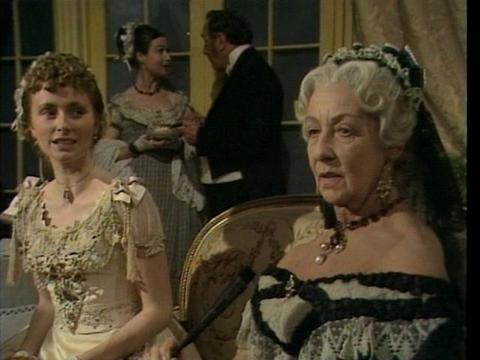
Lady Baldock (Ellen Pollock) remembering marriage, next to Violet (Mel Martin, who sees Phineas in the next adjoining room)
Lady Baldock. “No more than I could help. I just put up with it when it came. That’s about all you can do with marriage.”
Violet. “Oh you don’t paint a very romantic picture, aunt.”
Lady Baldock. “Nor would you if you’d been married to your uncle Baldock, but you’ll find all about it for yourself.”
Lady Glen. “Ah, you’re not against marriage, are you, Lady Baldock?”
Lady Baldock. “One can’t be against it because everybody does it, and Violet will have to do it like the rest. [pause and camera on Lady Glen’s face]
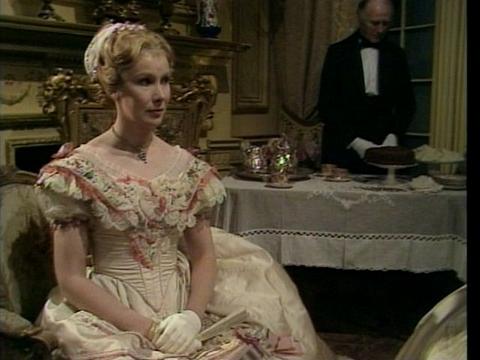
Lady Glen listening to Lady Baldock, remembering her own marriage too.
Lady Baldock. “It’ll be bad of course, especially as the men can smell her money, but I’m going to see to it that she don’t do worse than she has to.”
One of Lady Baldock’s proposed suitors is Lord Fawn; and he is introduced by a trio (Dolly, Madame Max, and Phineas) first discussing Phineas’s mysterious trip, and then turning to look at a new character, whom Dolly (performing once again his role as chorus) introduces as someone who lives with his mother in Richmond and “has a hundred and nineteen sisters,” with a very few talents, none of which he “hides under a bushel.” The camera moves to another trio they are looking at, Monk (Bryan Pringle), Fawn and Lady Laura. Fawn’s hypocritical shallow allegiance to progressive legislation is revealed; more, he is introduced as really unpleasant, a bigot, someone who by instinct does not like either Finn or Madame Max (she is more than an unknown outsider; she is “a foreign woman” and Fawn wonders why Lady Glen has invited her, at which Lady Laura makes one of the ugliest speeches in the whole series.
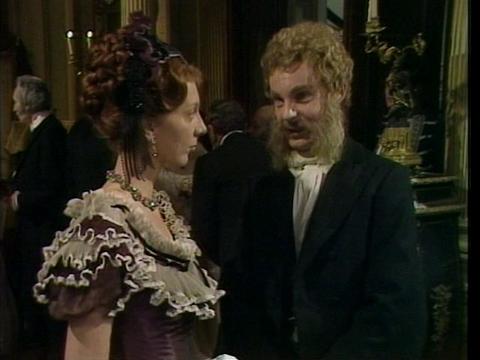
Lord Fawn (Derek Jacobi) indulging in nasty gossip about Madame Max with Lady Laura
Lady Laura. “Madame Goesler’s to be found under every roof. Like certain types of parasitic beetles, she arrives in the woodword without one’s knowing it, and then cannot be dislodged.” Prefiguring what will happen in the second phase of the Phineas matter (and happens in Trollope’s Phineas Redux), in another trio, Palliser defends Phineas against Fawn’s unjustified aspersions (in this case that Phineas doesn’t work hard, as if Fawn does; in a juxtaposed one Madame Max waxes more enthusiastic about coming reforms than Monk ever does (he is ever calculating who will oppose, how much it will take to push a bill, the price to be paid).
Madame Max. “I should want to vote for everything that could be voted for. Ballot, manhood suffrage, womanhood suffrage, the right to strike, the education [camera on Finn looking at her with liking] of every child inthe land.
Palliser. “That’s rather a strong program.”
Madame Max [not without irony]. “Not to those who believe in equality like all of us here.”
In contrast, Trollope’s Lord Fawn in Phineas Finn presented neutrally; he does not like Finn as his rival. Trollope’s Lady Laura never waxes this malicious; Raven presents Lady Laura far more unsympathetically than Trollope, and show sympathy for Kennedy.
The camera now segues into Madame Max and Phineas alone where she is now encouraging him (“no longer a tyro”) to fight for just causes, whereupon he cites “Irish Tenants Rights,” and her eyes light up. There aren’t many series where a hero and heroine fall in love through shared progressive priniciples. The rest of the conversations include one showing an instinctive antagonism between Phineas and Fawn, Lady Glen encouraging Fawn to tell all about his family (which we hear a very little of), Palliser and Phineas attempting conversation with Lady Baldock, Phineas wangling an invitation for her Tuesdays (after which Lady Glen shows her ambiguous allegiances as she tells Lady Baldock Phineas and Violet see “quite a lot” of each other. We move to Finn and Violet upon whom the scene ends; he is courting her, she teasing him; she asks what’s this about shooting in Kent? tells him Lord Fawn “don’t like the cut of your jib;” he crows he has an invitation to her aunt’s house on Tuesday, to which she replies, everyone is invited on Tuesday: “Candidate [for my hand] are invited on other days.”
Episode 8: “Match Gone Wrong.” Scene 9) Corridor and stairwell outside Palliser drawing room; Finn seen coming in through corridor; to Palliser and Lord Brentford (Lockwood West). This corridor familiar to us (among other events) as place where Burgo departed from; where Lady Glen wept at losing him.
Scene 10) Palliser drawing room again (where salon took place), daytime. Collingwood introduces Finn, Palliser and Lord Brentford waiting; Finn offered office of undersecretary for the colonies, warned he must vote with the party now, to which Finn (elated) says, “Why should I not?”, and Palliser replies: “Why not, indeed.” The salary is 2000 pounds. (In novel this offer is presented in the form of a a letter from Brentford to Phineas, Chs 43, p 419, 1972 Penguin)
Scene 10) Phineas leaves Mr and Mrs Bunce’s lodgings; in Trollope Mr Bunce says goodbye to Phineas, harshly sceptical of Phineas’s ability to stay true to liberal tenets and dialogue didactic; Raven wants us to find Phineas more reluctant, touching and bring in his deeper allegiance to Mary Flood Jones by their packing Mary’s picture together. A much more strictly political debate (whether one should take office, what good one does, begun by Trollope in Phineas Finn, Ch 18, in a debate between Turnbull and Monk) is here made one about identity. The modern way of thought is identity politics.
Scene 11) Kennedy drawing room London. Another quarrel between Lady Laura and Kennedy over Phineas: she comes in with gratifying news Phineas has won office very early, and when Kennedy grows irritated, she hypocritically apologizes for her gratitude to the man who saved his life, and his anger becomes too much for him to contain so he leaves (Raven picks up language from Ch 44, pp. 433-35, 1972 Penguin). Phineas enters as Kennedy leaves, and notes how Kennedy passed him without a word; Laura now agrees to arrange a meeting between Violet and Phineas, throwing over her brother, warning Phineas if he wins Violet, he will lose Lord Brentford’s favor. She does this because she cannot bear to “deny” him anything; because “it is you that wishes it.” We have yet another in the many close-ups of this pair of thwarted lovers; neither Raven nor Trollope sympathizes with Laura’s misery in her double life because she chose it; Raven sees her as betraying Kennedy; Trollope sees her as ambitious (a no no for a woman who must marry for love or learn to love whom she marries).
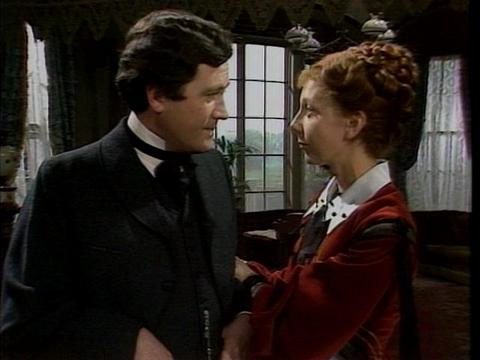
Phineas is told by Lady Laura that she will try to help him win Violet Effingham.
Scene 12) The park (St James?). Laura and Violet walking along, music from a band heard throughout. This is a powerful pivotal scene. Violet is literally pulled along by the arm by Laura; Violet distressed, disquieted by Laura’s now “pleading” for Phineas, and in Anna Massey’s eyes are a glittering half-crazed expression: she is vicariously trying to give herself to Phineas by giving him Violet.
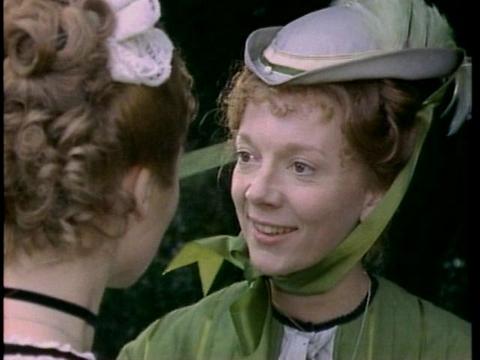
Lady Laura urges Violet to take Phineas because she (Laura) burns to give Phineas everything he wants.
Laura ducks behind a tree, and Violet sees Phineas (posed as in an illustration, a man in an elegant suit, top hat, cane lingering by a tree). Raven has taken material from Phineas Finn, Chs 45, pp. 440-442, Ch 46, pp. 444-46, the second called “The Mousetrap,” where Laura talks to Violet one day and on another Phineas finds Violet in Lady Baldock’s house, and Violet rejects him on the grounds she sees how shallow is his love for her as he had just loved Laura; and her memories of how true Chiltern has been to her from their childhood. Raven’s scene is more powerful, more penetrating: Violet rejects Phineas out of shock (paradoxically Raven makes her more innocent than Trollope does his proto-feminist Violet) and sexual and ethical disgust at Phineas’s ruthless use Laura’s love for him to make her into a gobetween. The band playing, use of colors, Laura behind a screen of greenery makes a parallel between Burgo Fitzgerald (Barry Justice) and Lady Glencora McClusky who also darted in and out of greenery in a green park, and whose love was thwarted. No idyllic innocent Arcadia now.
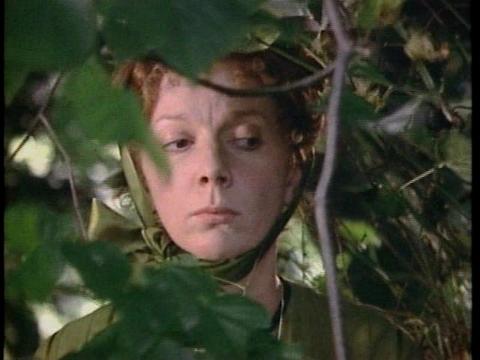
Laura hears Violet tell Phineas what a disgrace this is his using Laura as his gobetween because she loves Finn.
Violet tells Phineas he does not love her and Phineas looks surprized: “I not love you?”, and then pained at her words.
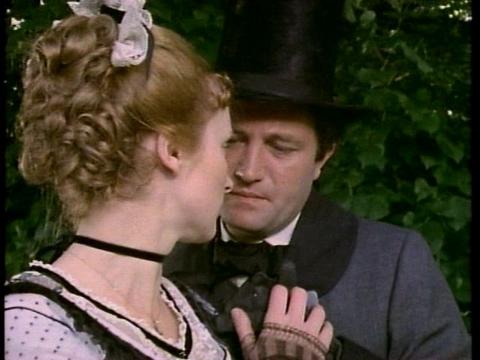
Violet tells Phineas what a disgrace this is his using Laura as his gobetween because she loves Finn.
Then the camera cuts Scene 13) a gorgeous picturesque take of a wild mountain and countryside, below which Phineas rises from having sex with Mary Flood Jones, and then lays down again—for a third time just off camera (the first occurred in 5:9) so Violet may have a point. Violet may not; it’s not clear Phineas loves any woman at this point, though he keeps asserting he loves three of the four possibilities put before him (Laura, Violet, and Mary; but not Madame Max, for whom he seems at this point to have a genuine friendship). This is in lieu of Phineas’s unexploitative love for Mary Flood Jones and proposal (Phineas Finn, Ch 68, po. 632-33, 1972 Penguin)
An interesting poetic use of language not found in Trollope, showing Raven creating in his own right is the use of bother. Phineas says he must go see Mr Monk, and Mary says “Bother, Mr Monk;” in Episode 9, in the train, Laurence Fitzgibbon accuses Phineas of creating harmful (to him, Fitzgibbon and landlords) “bother;” when in Episode 10, Madame Max comes upon Phineas desolate after diner at Matching, Phineas tells Madame Max he is troubled by “bother” deeper than Violet’s rejection of him.
Episode 9: “Irish Cause.” Scene 14) Phineas’s father’s house. Phineas first glimpsed with wide waistcoat, glass of brandy, cigar (he is living a comfortable life) and Monk, a strong scene whose results will shape Phineas’s future probably more than who he marries, for if he did follow the party line, even if he married Mary Flood, he’d have his salary and could hope to stay in public life in England. Raven substitutes the scenes in Trollope’s novel where Barrington Erle warns Phineas not to vote for Irish tenant right, and the scenes where Monk urges Phineas not to go out with him, but ignore what he said on the hustings; in Trollope only after Phineas has said he resigned his office, does Monk shake his hand with gratitude as of a fellow soldier in the good fight (Ch 67, p. 635, 640). Instead in Raven we get a scene where Monk urges Phineas to go with him, and Phineas is reluctant. Raven’s Monk also at the same time tells Phineas this will not be a debate, but a row and a nasty one, and we see an example of this on the train scene. Raven really gives strong voice to the Irish and just side of the matter as 20th century liberal people might see: Raven’s Monk tells Phineas his first loyalty should be to his constituency (but in the 19th century no Irish poor elected Phineas); Phineas and then Madame Max (at Lady Glencora’s salon and again at Matching) make the case that the Irish are being robbed of wealth they create out of their labor.
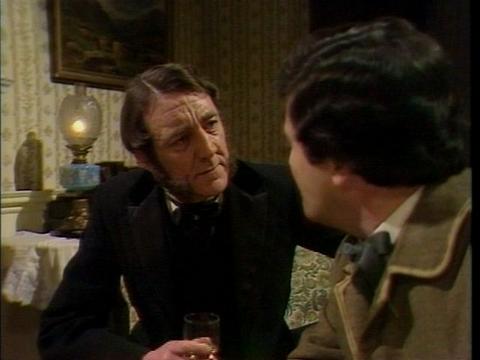
Monk (Bryan Pringle) tell Phineas their prior duty is to the Irish tenants.
Scene 15) Irish Countryside: Phineas on a horse watching a poor farmer fix the roof of his family’s rented hovel. As Nick comments, the scene is too picturesque to get across the great misery of the Irish; to do him justice, Trollope does describe this in Macdermots of Ballycloran and Castle Richmond.
Scene 16) On the new dining cars of the train. A wholly original scene on the train between Fitzgibbon and Phineas. First we see this luxurious dining car and Fitzgibbon says, well, look at this fine new invention, reasonable dining on a train. Now he doesn’t have to swallow down his meal in 20 minutes on a train station. It’s more than that: it’s luxury dining and we see the menu, the waiter, hear the dishes ordered. This connects to the British audience. I remember in 1969 when one did dine luxuriously on trains: very expensive it was too.
The scene contrasts directly with the poverty of the Irish tenants Phineas has just watched patching the house roof in the cheapest way possible as they will only see their rent rise if they do anything else.
Then the two get to talking and we see Fitzgibbon is very angry. He tells Phineas what he has been doing: trying to wrench money “out of the governor.” No go. Now he’s been honest, what has Finny been doing. Phineas begins to talk of what he saw with Monk and his intentions to work for Irish tenant right. Fitzgibbon not only argues the issue, but waxes insulting and nasty (a kind of soliloquy at length; very effective. After all he is an Irish person who is living high because of rents. He sneers at the idea the tenants tell any truths about their conditions, says he and his father know best as their family has been landlords for 200 years now, and what does Phineas know. Phineas concedes many Irish can lie, and he’s seen this in Fitzbgibbon, but some tell the truth. This ignites Fitzgibbon to tell Phineas his whole life is a lie, what is he doing hobnobbing with the great and rich; Fitzgibbon describes Phineas’s pursuit of women (we’ve just seen) as racing after purses, and he insults not only Phineas but needles him for his seducing of Mary (who we see is going to bed with Phineas) and then rams home an insult about Madame Max. Is Phineas going to give full pay in some way for her purse of gold. Every insult he can think of.Phineas stands up and says “goodbye Laurence.” Fitzgibbon sits there for a minute or so and then says lightly “bye.”
This is how friendships do end, and suddenly. Raven has made a plot trajectory where we first saw Phineas introduced by Fitzgibbon; it was Fitzgibbon who did help him along and get him into clubs and introduce him; but also Fitzgibbon who insisted on quid-pro-quo signing of a bill, putting Clarkson on Phineas’s tail, and Fitzgibbon who acted as second in the duel (ambiguous role). These dinner scenes, theatrical and private, begin to be common in Proust; Anthony Powell uses them very effectively and they are translated by John Mortimer into his brilliant (acclaimed) film adaptation of Evelyn Waugh’s Brideshead Revisited.
Scene 17: Matching Priory, one corner of drawing room, Palliser and Erle there, chairs, papers, welcome Phineas as one of themselves; now he is in the important lists of who gets what and who doesn’t, and is told Lord Brentford’s borough is going; Monk comes over as Lady Glen and Madame Max are seen walking to back of room, and Palliser leans over to confide his wife is once again pregnant (so a third baby on the way), and Phineas excuses himself to go over to Lady Glen, to another very different part of the room so Scene 18) Couch for guests with Phineas and Madame Max seated (as once Alice [Caroline Mortimer] sat with Lady Glen, or was harassed by Mr Bott [John Stratton, 2:3], and Lady Glen standing above them. In her welcome she sees Phineas is depressed, asks where is that “Irish smile,” and he obliges insofar as he can, Lord Chiltern is there, expressly asked so they can make up; so too is Duke of Omnium unexpectedly there; she leaves two alone and it’s here Madame encourages Phineas strongly to take up the cause of Irish Tenant Right.
Here is what Nick wrote about Madame Max in this part:
And then we have the emergence of Madam Max – which has been done slowly – as, at this point, the most positive character in the series. In the same drawing-room scene (at the Pallisers) when asked what she would do if she was in power, she talks of universal male suffrage, universal female suffrage, universal education of children and union rights! I use an exclamation mark because I was taken short by this; where does Raven get this from? (This is important to me because I am dubious as to whether Trollope would endorse collective struggle in this way.) The positions which Madam Max advances here are way in advance of any upper-class character I recall from Trollope. Is it from another book or character? Perhaps this is by the by, what Raven wishes to do is to use Madam Max to undercut this drawing-room liberalism by advancing a genuinely radical programme? By standing outside the political power games and talking of causes. Her status in this regard is reinforced when she discusses Irish Tenant Reform with Phineas. She offers her own observation on the situation in Hungary and Phineas then becomes passionate in his explanation of the position of the Irish tenants. Ellen has pointed out that this is not in Trollope. But also it is the first time that we have seen Phineas as a politically forceful and sympathetic figure; now he is not being ‘likeable’ (and he is very much more likeable for it!).
But the episode ends (as does Phineas’s conversation with Monk) with a close-up of Phineas’s troubled face. He does not want to lose all he has gained, and in the next episode Madame Max too refuses an offer because she too has too much to lose—and perhaps not enough to gain.”
Episode 10: “Marie’s Offer.” Scene 19) Arcadian setting of Matching Priory which recalls the beautiful grounds where the series begins, to which (though at different houses) it periodically returns. We also once again watch people dressed to the nines playing croquet. It begins with Madame Max and the Duke flirting over a game of croquet; they spy Lady Glencora’s entrance into the garden a third time, visibly very pregnant and holding the hand of the heir (another slightly older blonde child), a still which has been used for promotion (revealingly over and over again).
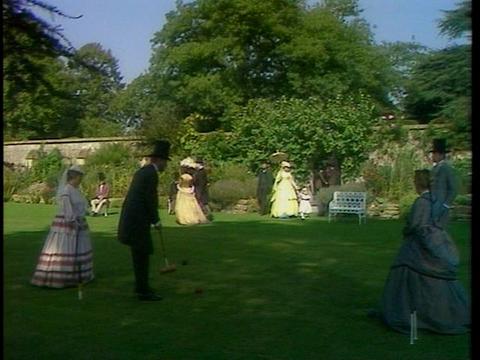
Lady Glen seen from afar by the Duke of Omnium and Madame Max: she is pregnant, with a boy heir in her hand.
And then, from her and Phineas’s angle, how she sees Madame Max as a threat.
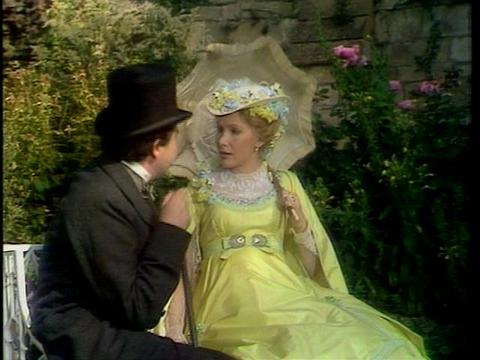
Lady Glen advises Phineas to marry Madame Max (so she will not have to fear the Duke marrying her).
Both scenes are wholly invented by Raven, but then he has Lady Glen with Phineas in this scene so it’s natural to give to Lady Glen the words Lady Laura in the novel uses to urge Phineas to marry Madame Max (see Phineas Finn, Ch 59, pp. 655-56, 1972 Penguin). Further, Raven’s film conception of Lady Laura would not allow this kind of contradiction; modern women really cherish their sexuality is our idea; they are not so complacent about arranged marriages, not so performative, and Raven’s Lady Laura has been evil-tongued and viciously jealous about Madame Max twice. In the book we have the deadly irony of Lady Laura’s misery and the ironic contradiction she now urges Phineas to violate his presumed emotional life; Phineas points this out to her (see Phineas Finn, 1972 Penguin Library edition by John Sutherland, Ch 59, pp. 655-56).
Now in Lady Glen’s mouth this urging has a very different connotation, and Raven makes astute use of this to bind his cycle of films. We are brought back to the first part of the series (1:1) where Lady Glen was sold to Plantagenet as a rich breeder by her aunts; earlier in this Part we see Lady Glen look darker and melancholy again when Lady Baldock talks of how she was married off and had to endure it. What then has she given all, including her body (and we realize she does not like to be a breeding pigeon and cow even if the promotional people like to show the character that way). She leans down and urges the child to run to his great-uncle—and interrupt the tete-a-tete. She tells Phineas had she known the Duke was coming even though she likes Madame Max and wants to be friends, and keep an eye on her, she would not have invited her for a time at Matching with the Duke in the house.
Phineas then spies Chiltern coming forward and his face lights up. (He didn’t mind being shot at for real when he lifted his arm it seems; “noblesse oblige” indeed.) And we get the two reconciled, thus bringing close to another long-trajectory of friendship highlighted in the film in a different way from the book; one of sincerity apparently, against false politics (emphasized by Phineas’s goodbye scene with Mrs Bunce who is afraid Phineas will betray himself, his origins, his ideals); this contrasts to the breakup of Phineas and Fitzgibbon on the train.
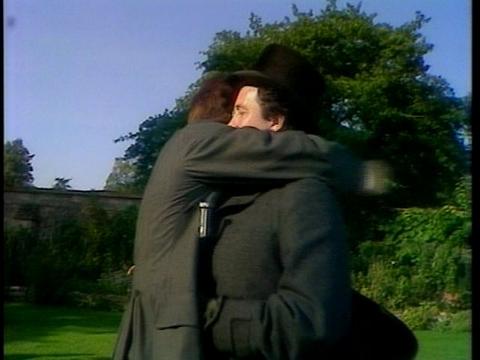
Chiltern’s intense impulsive response to Phineas’s held out hand
This segues into them discussing Laura’s misery and Chiltern telling Phineas Violet’s visit will not help Laura; “There is no woman that Laura needs.” This makes Laura sound like Maggie the Cat in Williams’s Cat on a Hot Tin Roof
Scene 20) Dissolve into scene of silent misery and depression on Loughlinter hill: Lady Laura leans against folly; Kennedy comes up to her and again there is sympathy for the man who hesitates, looks disappointed, calls her “my wife,” he is abject but calls her in. Silent dumb show on her part.
Scene 21) Matching priory drawing room, after dinner, the last scene of 5:10. Their faces are open to one another.
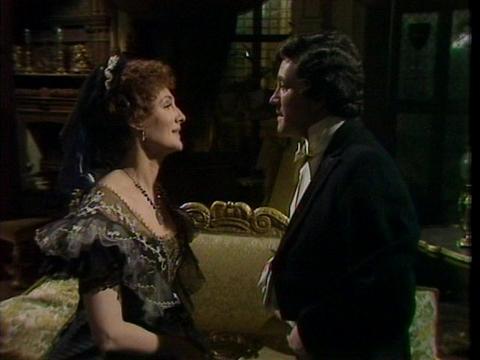
Madame Max (Barbara Murray) showing her intense affection and respect for Phineas; and he reciprocates. Open faces.
It is now evening, she comes upon him just after he puts down a newspaper, desolate at the coming choices he faces, and she comes up to talk and we see how she is a true friend to him when she encourages him to stay true to the just cause of Irish Tenant Rights, just before she offers him money in aid (not herself as a mistress though as in the book). Raven’s dialogue combines the best lines for his purpose from three different scenes between Phineas and Madame Max:
1) Penguin edition, Ch 54, p. 515 where she urges Phineas to pay attention to political ideas now that his apprenticeship is over and he has made his way into their mutual world; with new ones from;
22) Ch 72, pp. 678-84, p. 682 where she makes him an offer of all her income and herself, and he rejects it, a powerful scene which in the book takes place in her house, after she has sung to him and after he has engaged himself to Mary Flood Jones. In the film although he has been physically having sex with Mary there has been no promise, nor does Madame Max offer herself sexually, so the film is actually at once less humiliating to Madame Max and more careless of the working class Irish girl. Fascinating here, as it would seem Trollope is more careful of the working class girl, but that may be because he has presented Madame Max as no virgin and so doesn’t respect her in the way he automatically presents virgins as protected by men (right, yeah). In the film too the scene is emasculated of intensities because they are in the Palliser residence and there is no chance they can fall into one another’s arms openly.
The Duke interrupts and with a wave of his hand can send Phineas away. He is the Big Man of the series now, the one with whom we began on a throne in 1:1. Again Raven transposes scenes from Trollope’s novel. He takes material which occurred much earlier in the book (Ch 57, pp. 547-48) where the Duke asks Madame Max to accompany him to Lake Como; again the words are changed here so that Madame Max is sharper and more bitter after accepting his longing for her with kindness. There is a beautiful romance like antiphony to the dialogue which Raven writes:
Duke: I know of a man who will be very lonely in his villa by Lake Como this autumn.
Madame Max: And I know of a lady who will be very lonely in Vienna this autumn.
But as she turns to leave she sweeps him an elaborate (ironic courtesy) and says to his question about what he should put in a letter to her, that “He already knows it will be no use to send for her for his light entertainment.” Trollope had used a word we find in Milton for sexual exploitation of a supposedly delicious type; “dalliance.”
It’s at that moment Lady Glen comes in and we get one of these remarkable confrontation scenes where two characters stand apart and look at one another. We have had at least five thus far (see above). This one between Madame Max and Lady Glen may be read as a replay of the the bethrothal of Palliser and Lady Glen (1:1). Now Lady Glen richly dressed and very pregnant faces Madame Max; she does not like being pregnant; we know it’s dangerous (from Palliser’s anxiety and explicitly referred to by Collingwood [Maurice Quick] in the last Part, 5:9); her reward was to be Duchess, to have her son the new Duke. They do not draw together.
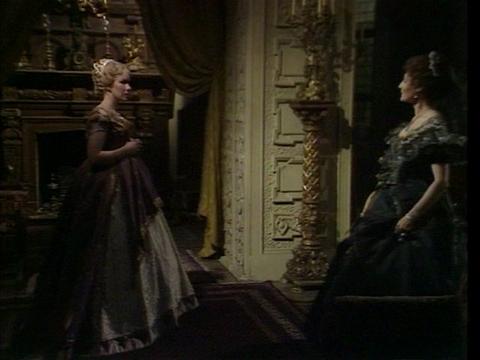
Lady Glen faces Madame Max.
There are a pair of closed faces if ever there were a pair. Lady Glen has not been nasty in the way of Lady Laura, but she does not recognize herself in Madame Max as yet, for Madame Max has the same problems as all the woman in the series. I am not sure Raven is conscious of this, only that he has a strong tendency to identify with outcasts and those vulnerable to be outcast so he said Lady Glen was the heroine of the series because she was someone always (in his mind) not part of the establishment for real. Burgo was his tragic hero (not Trollope’s) and in this Phineas matter Madame Max and Phineas are ever in danger of being cast out and thus more admirable, the more decently they behave to others, even if it’s partly because wisdom tells them they must.
This moment is tremendous as it brings back to us the opening of the series, all that Lady Glen has given up, reminds us that if Madame Max were to take the duke’s offer she would end up more lonely than ever. It’s not a man she is lonely for but a world to belong too. In the dialogue between Phineas and Chiltern about Lady Laura having to stay in Loughlinter in this episode, Chiltern says to Phineas’s idea Violet could visit Laura that “it’s no woman she longs for”, i.e, she’s like a “cat on a hot tin roof” wanting sex—a coarse way of seeing Lady Laura which is Raven’s view and not Trollope’s. As with 5:9 one sign Raven is working at a level of originality as a poet dramatist is the buildup of such word patterns, contrasts and similiarities within this episode.
The Part ends on the Duke sitting on his couch staring off into space. We lose sight of the very pregnant Lady Glen, as he has lost sight of what he has used her for.
Syvlia
--
Posted by: Ellen
* * *
Comment
- Rewatching Pallisers 5:10 yesterday straight through (to remind myself before returning to take notes and the screenplay down) I’ve noticed something emerging.
It’s been mentioned (by Nick) how unusual is the sympathy for Kennedy shown. I feel this is accompanied by a considerable blackening of Lady Laura. While I sympathize intensely with her wild desperation as she vicariously tries to substitute Violet for herself, and her obvious increasing depression, not everyone would, and the titles (headers) of the episodes suggest Raven blaming Lady Laura for Phineas not gaining Violet. Unlike the book, Raven’s Violet has no long-standing childhood memories, and she does not enter into Chiltern’s subversion of the establishment (kept at a minimum in Raven anyway).
Together with Raven’s sympathy for Kennedy and the bigoted way Lady Laura approaches Madame Max (calling Madame Max vile insect terms all the while we have just listened to Madame Max’s high liberal ideas, deep compassion, understanding for Phineas, selfless encouragement of him to fight for Irish Tenant Rights). So Lady Laura’s meanness, and Finn’s double life is presented as partly the result of Laura Standish’s original snobbery and desire ruthlessly to use Kennedy and not think about his point of view (no matter how we may not like it).
She shows an underlying treachery in her use of her husband, pushing Phineas about and using him. Trollope does punish Laura but she is not configured in the plot this hostile way. Raven really seems to dislike Lady Laura at times, and in so doing contributes to the anti-feminism or masculinist and at times misogynist presentaation of older women particularly in this series. Women are liked who want to have heterosexual sex with men and give themselves to men, and make no trouble for them. So our sympathies are to go to Mary Flood (who will emerge as comically conventional when she marries Phineas, is pregnant and worries about educating their child!).
Raven’s own carelessness comes out in Phineas’s treachery to Mary which I feel he is not really blamed for since the only one to bring it up is Fitzgibbon and he does this to get back at and insult Phineas.
On Trollope-l we had much discussion about the relatoinship of brothers and sisters in Trollope over the years. Most recently Nick talked about how Trollope was willing to let the sisters in his novels betray their women friends & relatives (cousins) for their brothers, and blamed for this, though the brother’s need was vindicated and the sister then dismissed to loneliness or solitude or some kind of half-life punishment. In the cases we had before us the sister wanted to inveigle her friend to marry her brother no matter how dangerous for the friend would be such a marriage, how cruel the brother could be. Those who wrote agreed that Trollope found the women dispensable in these cases; what mattered was what happened to the man, and that Trollope disapproved of women being aggressive in this way.
What we did not discuss was that the sister wanted herself to vicariously be the brother’s wife. In the case of Alice and Kate Vavasour, at one passionate moment, Alice does needle Kate this way. Remember I’m to be his wife.
This kind of suggestiveness emerges when Lady Laura suddenly turns round and attempts to help Phineas get Violet for his wife. Trollope sounds the same note.
What he does not go on to do is suggest Lady Laura has become half-crazed with strong sexual desire for Phineas. In her case she is not his sister. She has wanted to go to bed with him herself. In her case she’s actually betraying her brother, and trying to match her cousin, Violet, with her own near lover. This Raven does. And Anna Massey acts the part with magnificent intensity.
E.M.
— Elinor Apr 14, 1:46pm #
commenting closed for this article
